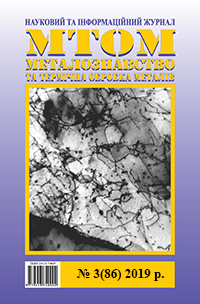Improvement of the technology of melting ingots of nickel based alloys by vacuum arc remelting (VAR)
DOI:
https://doi.org/10.30838/J.PMHTM.2413.250619.45.321Keywords:
smelting charge, alloying element, nickel alloy, metal melting, ingot, structure, propertiesAbstract
Abstract. Purpose. Improvement of the technological modes for the melting of nickel-based cathodes of composition Ni−Cr−Al−Y in order to improve their quality, namely, reducing the total number of defects in the form of discontinuities, pores, non-melts and increasing the homogeneity of the structure and chemical composition. Methods. To prepare the smelting charge for melting, the raw materials were chopped to the required size and mixed, which made it possible to ensure uniform distribution of the alloying elements in the entire volume of the smelting charge. To obtain experimental ingots, a vacuum-arc furnace was used. The mass of smelting-charge loading per melting was 4 000…6 000 g. Testing of melting modes was carried out by experimental implementation of the process. The range of modes is as follows: I = 450...1 800A, U = 30...45 V, t = 25...35 min, preliminary creation of a vacuum of 1∙10-4 mbar. The operating fluid is Ag/He gas mixture (70/30), pressure 0.5 bar, temperature of chill mold heating − 250…800 °С, melt temperature before pouring − 1 400…1 700 °С. For a comprehensive assessment of the chemical composition, a study was conducted in two zones of ingot fragment, in the central part of the sample and on its surface. The chemical composition studies were performed using a multipurpose scanning electron microscope REM 106І equipped with a microanalysis system. Metallographic studies of the obtained structure of the ingot were carried out using optical and electronic microscopes. Results. It has been established that the use of vacuum-arc remelting process to produce nickel-based alloys using preparation methods of smelting-charge with various size and refining the melting process parameters allows to produce ingots with a minimum number of proper defects, with the formation of a uniform structure and uniform distribution of alloying elements in the entire alloy. Scientific novelty. The regularities of the influence of the technological parameters of the charge preparation and the melting process on the structure and properties of nickel-based superalloys are established. Practical significance. Practical use of the obtained results will significantly improve the homogeneity of ingots in the production of cathodes for coating, which in turn will have a positive effect on the quality of applied coatings and the total resource of parts.
References
Sims Ch.T. Supersplavy II: zharoprochnye materialy dlya aehrokosmicheskih i promyshlennyh ustanovok[Superalloys II: heat-resistant materials for aerospace and industrial installations]. Moscow : Metallurgiya Publ., 1995, 384 p. (in Russian).
Maslenkov S.B. Spravochnik zharoprochnyh stalej і splavov [Reference book of heat-resistant steel and alloys]. Moscow : Metallurgiya Publ., 1983, 192 p. (in Russian).
Yefanov V.S., Klochikhin V.V., Pedash A.A. and Shylo V.G. Vlijanie tehnologii izgotovlenija katodov na kachestvo pokrytij lopatok turbiny [The effect of cathode manufacturing technology on the quality of turbine blade coatings]. Vestnik dvigatelesroeniya [Bulletin of engine building]. 2018, no. 1, pp. 132−137. (in Russian).
Ovchinnikov A.N., Teslevich S.M., Tizenberg D.L. and Yefanov V.S. Tehnologija vyplavki slitkov dlja poluchenija katodov iz kobal'tovago splava sposobom dugovogo pereplava [Technology of melting ingots of cobalt alloy by the arc remelting method]. Sovremennaja jelektrometallurgija [Modern electrometallurgy]. 2019, no. 1, pp. 23−27. (in Russian).
Paton B.Y., Trigub N.P. and Ahonin S.V. Elektronno-luchevaya plavka tugoplavkih I vyisokoreaktsionnyh metallov [Electron beam melting of refractory and highly reactive metals]. Kyiv : Nakova dumka Publ., 2008, 213 p. (in Russian).
Mysik R.K. Litejnye splavy na osnove tjazhelyh cvetnyh metallov [Casting alloys based on heavy non-ferrous metalsd on heavy non-ferrous metals]. Ekaterinburg: Ural'skogo universiteta Publ, 2016, 140 p. (in Russian).
Aslanjan I.R. and Ospennikova O.G. Sovremennye tendencii razvitija tehnologii izgotovlenija model'nyh kompozicij dlja lit'ja zharoprochnyh splavov [Modern trends in the development of technology for making model compositions for casting superalloys]. Fundamental and applied research in the field of creating foundry heat-resistant nickel and intermetallic alloys and highly efficient technologies for the manufacture of GTE parts : scient. and tech. conf., 2017, pp. 49−58. (in Russian).
Gorjunov A.V. and Rigin V.E. Sovremennaja tehnologija poluchenija litejnyh zharoprochnyh nikelevyh splavov [Modern technology for casting high-temperature nickel alloys]. Aviacionnye materialy i tehnologii [Aviation materials and technologies]. 2014, no. 2, pp. 3–7. (in Russian).
Sidorov V.V., Rigin V.E. and Kablov D.E. Organizacija proizvodstva lityh prutkovyh zagotovok iz sovremennyh litejnyh vysokozharoprochnyh nikelevyh splavov [Organization of production of cast bar stock from modern foundry high-temperature nickel alloys]. Litejnoe proizvodstvo [Foundry]. 2011, no. 10, pp. 2−5. (in Russian).
Nochovnaja N.A., Kochetkov A.S., Bokov K.A. and Ivanov V.I. Issledovanie litejnyh harakteristik zharoprochnogo intermetallidnogo titanovogo splava VTI-4 [Research of casting characteristics of heat-resistant intermetallic titanium alloy VTI-4]. Trudy VIAM : jelektron. nauch.-tehnich. zhurn., 2017, no. 5, art. 02.
Downloads
Published
Issue
Section
License
Authors that are published in this journal agree to follow the conditions:
Authors reserve the right to the authorship of his work and cede the right to the journal of first publication of this work on conditions of the license under the Creative Commons Attribution License, which allows others to distribute it freely with the obligatory reference to the author of the original work and the first publication of the work in this journal.

